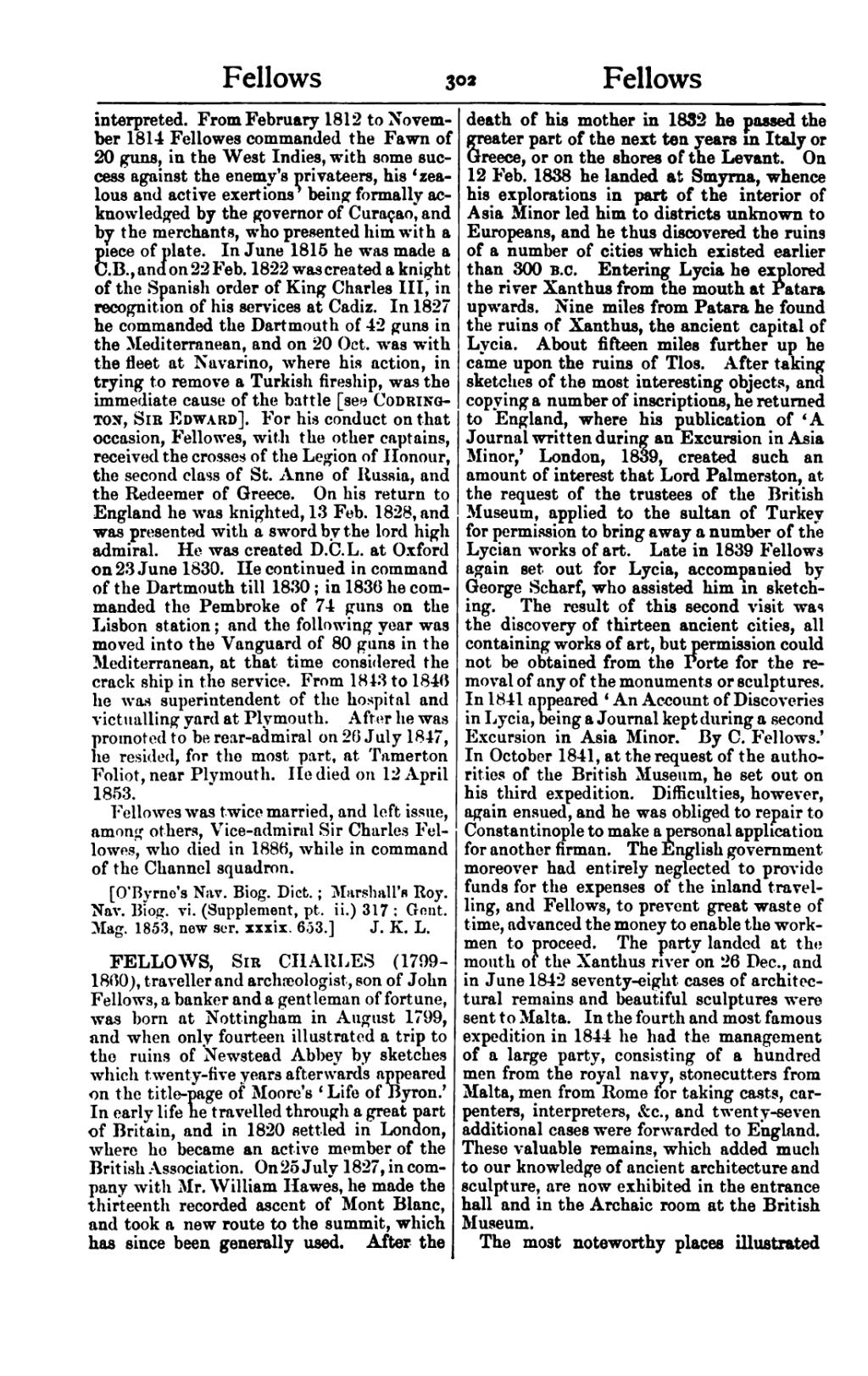interpreted. From February 1812 to November 1814 Fellowes commanded the Fawn of 20 guns, in the West Indies, with some success against the enemy's privateers, his ‘zealous and active exertions’ being formally acknowledged by the governor of Curaçao, and by the merchants, who presented him with a piece of plate. In June 1815 he was made a C.B., and on 22 Feb. 1822 was created a knight of the Spanish order of King Charles III, in recognition of his services at Cadiz. In 1827 he commanded the Dartmouth of 42 guns in the Mediterranean, and on 20 Oct. was with the fleet at Navarino, where his action, in trying to remove a Turkish fireship, was the immediate cause of the battle [see Codrington, Sir Edward]. For his conduct on that occasion, Fellowes, with the other captains, received the crosses of the Legion of Honour, the second class of St. Anne of Russia, and the Redeemer of Greece. On his return to England he was knighted, 13 Feb. 1828, and was presented with a sword by the lord high admiral. He was created D.C.L. at Oxford on 23 June 1830. He continued in command of the Dartmouth till 1830; in 1836 he commanded the Pembroke of 74 guns on the Lisbon station; and the following year was moved into the Vanguard of 80 guns in the Mediterranean, at that time considered the crack ship in the service. From 1843 to 1846 he was superintendent of the hospital and victualling yard at Plymouth. After he was promoted to be rear-admiral on 26 July 1847, he resided, for the most part, at Tamerton Foliot, near Plymouth. He died on 12 April 1853.
Fellowes was twice married, and left issue, among others, Vice-admiral Sir Charles Fellowes, who died in 1886, while in command of the Channel squadron.
[O'Byrne's Nav. Biog. Dict.; Marshall's Roy. Nav. Biog. vi. (Supplement, pt. ii.) 317; Gent. Mag. 1853, new ser. xxxix. 653.]
FELLOWS, Sir CHARLES (1799–1860), traveller and archæologist, son of John Fellows, a banker and a gentleman of fortune, was born at Nottingham in August 1799, and when only fourteen illustrated a trip to the ruins of Newstead Abbey by sketches which twenty-five years afterwards appeared on the title-page of Moore's ‘Life of Byron.’ In early life he travelled through a great part of Britain, and in 1820 settled in London, where he became an active member of the British Association. On 25 July 1827, in company with Mr. William Hawes, he made the thirteenth recorded ascent of Mont Blanc, and took a new route to the summit, which has since been generally used. After the death of his mother in 1832 he passed the greater part of the next ten years in Italy or Greece, or on the shores of the Levant. On 12 Feb. 1838 he landed at Smyrna, whence his explorations in part of the interior of Asia Minor led him to districts unknown to Europeans, and he thus discovered the ruins of a number of cities which existed earlier than 300 B.C. Entering Lycia he explored the river Xanthus from the mouth at Patara upwards. Nine miles from Patara he found the ruins of Xanthus, the ancient capital of Lycia. About fifteen miles further up he came upon the ruins of Tlos. After taking sketches of the most interesting objects, and copying a number of inscriptions, he returned to England, where his publication of ‘A Journal written during an Excursion in Asia Minor,’ London, 1839, created such an amount of interest that Lord Palmerston, at the request of the trustees of the British Museum, applied to the sultan of Turkey for permission to bring away a number of the Lycian works of art. Late in 1839 Fellows again set out for Lycia, accompanied by George Scharf, who assisted him in sketching. The result of this second visit was the discovery of thirteen ancient cities, all containing works of art, but permission could not be obtained from the Porte for the removal of any of the monuments or sculptures. In 1841 appeared ‘An Account of Discoveries in Lycia, being a Journal kept during a second Excursion in Asia Minor. By C. Fellows.’ In October 1841, at the request of the authorities of the British Museum, he set out on his third expedition. Difficulties, however, again ensued, and he was obliged to repair to Constantinople to make a personal application for another firman. The English government moreover had entirely neglected to provide funds for the expenses of the inland travelling, and Fellows, to prevent great waste of time, advanced the money to enable the workmen to proceed. The party landed at the mouth of the Xanthus river on 26 Dec., and in June 1842 seventy-eight cases of architectural remains and beautiful sculptures were sent to Malta. In the fourth and most famous expedition in 1844 he had the management of a large party, consisting of a hundred men from the royal navy, stonecutters from Malta, men from Rome for taking casts, carpenters, interpreters, &c., and twenty-seven additional cases were forwarded to England. These valuable remains, which added much to our knowledge of ancient architecture and sculpture, are now exhibited in the entrance hall and in the Archaic room at the British Museum.
The most noteworthy places illustrated
